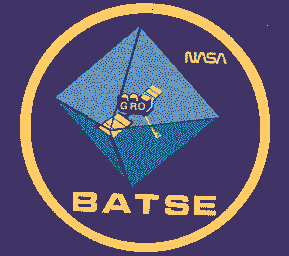
The Burst and Transient Source Experiment Team at UCSD
The BATSE team at UCSD, led by BATSE Co-Investigator Dr. Jim Matteson,
studies the spectroscopy of gamma ray
bursts, transient flashes of gamma rays from outside the Solar
System. The origin of gamma ray bursts is currently uncertain, and
they are perhaps the most mysterious astrophysical phenomenon. Members
of the team at UCSD analyze spectroscopic data from the Burst And
Transient Source Experiment (BATSE), one of four instruments aboard
the Compton Gamma Ray Observatory (CGRO).
BATSE's primary purpose is the study of gamma ray bursts, but it has
been extremely successful in observing solar flares, discovering gamma
ray transients and monitoring the gamma ray sky.
Most of the BATSE instrument team is at Marshall Space Flight Center
(MSFC), and it
is from there that the instrument is operated, and the telemetry from
the detectors is processed. BATSE's Principal Investigator, Dr. Gerald
J. Fishman, works at MSFC.
At UCSD we are primarily concerned with burst spectroscopy. The most
pressing issue is whether absorption lines between 15 and 100 keV are
found in the BATSE spectra. Absorption lines have been reported by
previous missions, and were attributed to cyclotron absorption in very
strong magnetic fields (~10^12 gauss). Using the large number of
bursts observed by BATSE, we are also characterizing the shape of the
burst spectrum and its evolution. In addition, we study the burst
location distribution. On a more mundane level, we are active in
instrumental issues such as calibrating our detectors, identifying
(and if possible, mitigating) electronic artifacts, and determining
the optimum settings.
Burst Links at UCSD
Burst Links Elsewhere
-
The BATSE page at MSFC
-
The CGRO Science Center (GROSSC)
-
BACODINE
-
Gamma Ray Optical Counterpart Search Experiment
(GROCSE)
-
Mission concept: Continuous Hard X-ray Imager for Astrophysics
(CHIP)
-
Mission concept: Burst Locations with an Arc Second Telescope
(BLAST)
-
Mission concept: Burst ArcSecond Imaging and Spectroscopy
(BASIS)
-
Mission concept: All-sky Low Energy Gamma Ray Observatory
(ALLEGRO)
-
Mission concept: ANDROMEDA
-
Bursts observed by
OSSE
-
Bursts observed by
COMPTEL
-
High-Energy Transient Experiment
(HETE)
Other Links at UCSD
Last updated July 2, 1998.
This page is maintained by David Band, dband@ucsd.edu
